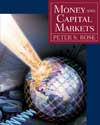 |  Money and Capital Markets: Financial Institutions and Instruments in a Global Marketplace, 8/e Peter Rose,
Texas A & M University
Introduction to the Money Market
Chapter SummaryThis chapter has presented a broad overview of one of the most important components of
any financial system, the money market. Money markets are among the largest of all financial
system components and provide numerous services that modern savers and borrowers
cannot do without in the modern world.
- Money markets are defined as the collection of institutions and trading relationships that
move short-term funds from lenders to borrowers and back again.
- All money market loans have an original maturity of one year or less. Thus, money market
transactions typically consist of credit flows from lenders and borrowers that last for
only hours, days, weeks, or months, unlike the capital markets where credit transactions
may cover many years.
- Most loans extended in the money market are designed to provide short-term working
capital to businesses and governments so they can purchase inventories, pay dividends
and taxes, and deal with other immediate needs for cash. Their short-term cash needs
arise from the fact that inflows and outflows of cash are not perfectly synchronized. In
the real world, even with the best planning available, temporary cash deficits and temporary
cash surpluses are more often the rule rather than the exception.
- The money market simultaneously answers the needs of borrowers for short-term credit
and the needs of lenders of funds (savers) for temporary interest-bearing outlets for their
surplus funds.
- Money market investors are typically extremely conservative when it comes to placing
their savings in financial instruments. They usually will accept little or no risk of borrower
default, prefer financial instruments whose prices are stable, and usually require
an investment from which their funds can be recaptured quickly (i.e., they prefer assets
with high liquidity and marketability).
- Nearly all money market instruments are of prime quality—among the safest, most liquid,
and most readily marketable assets that are available anywhere within the financial
system.
|
|




 2003 McGraw-Hill Higher Education
2003 McGraw-Hill Higher Education